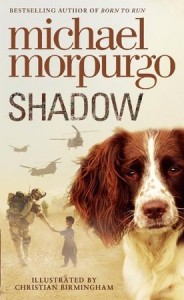Have a great summer full of many books. The ReaderKidZ – Nancy, Stephanie, Debbie, Dianne, and Ann – look forward to seeing you back here in the Fall.
A Chicken Squad, in The Middle of Nowhere, on Planet Kindergarten
Upside Down in the Middle of Nowhere by Julie T. Lamana (Chronicle Books, 2014)
Armani Curtis is turning ten and it’s huge deal, with a big cake, and a certain wrapped box. Then Hurricane Katrina hits New Orleans and the Lower Nines and everything, everything changes.
This moving story of courage and, ultimately, survival in the face of difficulty is one that doesn’t gloss over the hard realities. Yet, it’s full of hope and the incredible power of a love that somehow manages to deal, even when faced with tragic devastation.
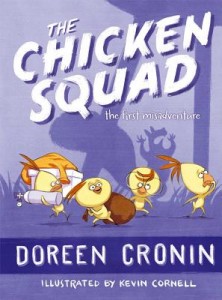 Chicken Squad by Doreen Cronin, illustrated by Kevin Cornell (Atheneum Books for Young Readers, 2014)
Chicken Squad by Doreen Cronin, illustrated by Kevin Cornell (Atheneum Books for Young Readers, 2014)
As the author of many best-selling picture books, Doreen Cronin is a familiar name (Diary of a Worm, Click, Clack, Moo). Her newest, Chicken Squad is written for those kids who’ve moved up to chapter books.
Dirt, Sweetie, Poppy, and Sugar – from an earlier series about JJ. Tully – are the “shortest, yellowest, fuzziest detectives in town.” Full of personality and spunk, the Chicken Squad makes for a laugh-out-loud, early chapter series that’s even better in this new and highly illustrated format .
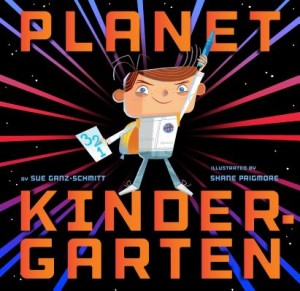
Planet Kindergarten by Sue Ganz-Schmitt, illustrated by Shane Prigmore (Chronicle Books, 2014)
It’s not easy finding a “starting school” book that hasn’t already been done. And then, along comes Planet Kindergarten. Bright illustrations and lively text were enough to capture the eye and ear of a certain preK student I know who gobbled the book right down and immediately asked to read it again. Kindergarten can be scary, after all, and the commander has a long and complicated flight plan: “I try to get used to the new atmosphere, but it’s not like home. For one thing, gravity works differently here. We have to try hard to stay in our seats. And our hands go up a lot.”
This book will have kids and adults wishing they were able to “boldly go where they’ve never gone before: Planet Kindergarten!”
Guest Librarian Picks: MORE Great Summer Reads!
Summer time leads to adventures of road trips, traveling, camps and more time to engage your brain in reading! These books involve characters who are daring, brave and highly entertaining. If you want to be swept away, pick up one of these books and dazzle your brain power.
Younger Readers:
Have You Seen My Dragon? By Steve Light
This is a delightful picture book about a missing dragon in New York City with illustrations that engage the reader and highlight the city-scape of Manhattan. Whether searching in Central Park or the city landmarks, children will enjoy the black and white illustrations and searching for the hidden dragon on every page. The hidden image appears in color contrasting with the scenery and objects to count on every page.
Transitioning Readers:
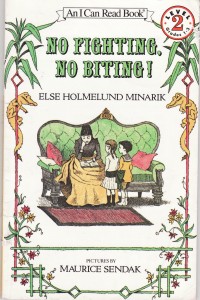 No Fighting, No Biting! By Else Holmelund Minarik, Illustrated by Maurice Sendak
No Fighting, No Biting! By Else Holmelund Minarik, Illustrated by Maurice Sendak
The classic tale of bickering siblings is a read aloud icon and includes several short stories– “Cousin Joan,” “Lightfoot and Quickfoot,” “On the Way Home,” and “Rosa’s Tooth,” in this illustrated edition. Transitioning readers will enjoy reading aloud to adults and engaging in the hilarious dialogue.
Older Readers:
Michael Morpurgo’s Shadow is a triumphant story about a lost dog, a friendship, and the power of human hope in the face of dire circumstances. (This is NOT a sad, dog book. I repeat it is NOT sad…my students always ask me because the cover has such an adorable spaniel on it.) Shadow is an exciting story about how a dog changes three people’s lives–Aman, a refugee from Afghanistan, his British friend Matt and Matt’s grandfather, a former journalist. Aman is living at a detention center with his mother, awaiting deportation back to Afghanistan, after living in the UK for five years. Matt asks his grandfather to go visit Aman in the detention center and find out what’s happening to his friend. Through interviews, Matt’s grandfather slowly discovers Aman’s story and with Matt, they hope to rescue Aman before he must leave the country.
Megan Poynter Fink is a middle school librarian at Charlotte Country Day School. She began her career working in publishing and for the New York Public Library. She is an active member of YALSA and has served on YALSA’s Award for Excellence in Nonfiction for Young Adults, Teen Read Week and Best Books for Young Adults committees. Megan has written for VOYA and BOOKLINKS magazines. She enjoys cooking, Zumba classes and city adventures in Charlotte, NC.
The Secret Hum of a Daisy, by Tracy Holczer
Tracy Holczer’s debut The Secret Hum of a Daisy is perfect for the thoughtful, careful reader in the upper-age bracket of the ReaderKidZ spectrum. It’s a tender story that is best read slowly, taking great care to note clue-filled literary nuances of character and setting. The Secret Hum of a Daisy pairs perfectly with a wonderfully lazy, cloud-filled summer afternoon with nothing in the world to do but read!
Grace’s mother has died and she is forced to live with her estranged grandmother. Grace and her flamboyantly creative mother had been perpetually on the move, living like gypsies never staying in one place for very long. Mama’s passing left Grace no alternative but to sprout roots and move to her mother’s small town childhood home, residing with a woman she wants nothing to do with. Though initially belligerent and cruel, Grace discovers clues that eventually lead to an emotional understanding of her grandmother, acceptance of those whose lives had been shattered by love and loss, and an appreciation for a community whose affection for her had been present since the day she was born.
I took a pencil and let the words come. All those words about Mama and the night she died that I’d been stuffing down. When they were all out, I folded that piece of a paper into a tight square and shoved it in my pocket.
That was how I saved myself (283).
In which a young boy confronts vampire bats, deadly snakes, cockroaches the size of hamsters … and that’s just the beginning.
Chapter One. In which Jack is unfortunately reunited with his parents … and we’re off! Jack likes school, staying indoors, and normalcy. His parents like adventure, wandering the world in pursuit of their hair-brain schemes, and remote places. This is one parent-child mismatch that’s sure to give many-a-young reader hours of fun. In Jack the Castaway – Book #1 of the new middle grade Berenson Schemes series by Lisa Doan and illustrator Ivica Stevanovic – Jack has been happily staying with his spinster Aunt Julia while his parents explore the Amazon on one of their get-rich-quick schemes. Unfortunately, poor Aunt Julia is hit by a bus and his parents’ scheme fails, so Jack’s forced to go with them on their newest idea to start a snorkeling business on a remote Caribbean island. Roaches the size of hamsters, deadly snakes in the middle of the night, a ship wreck that leaves Jack alone on an uninhabited island … and that’s only the good news.
It will all work out. Or will it?
For readers who like adventure or humor or the pitting of child-against-parents, this one’s a winner. The best news is that the second book in the series – Jack and the Wild Life – will be published in August. Any boy whose first thought upon finding himself alone on a desert island is to wash his clothes is sure to be an hilarious companion this summer.
Read It and Laugh: More Hot Summer Series for Kids
Alien Encounter by Charise Mericle Harper (Book 1 of the Sasquatch and Alien series (Christy Ottaviano Books/Henry Holt & Co.)
Fourth-grader Morgan Henry meets a new-kid-in-town when the latter is stuck hanging in a tree with a “giant wedgie.” The boys bond after Morgan cuts Lewis free (and thump, down). Line drawings throughout illustrate this and many other similarly compelling situations.
The whole book, in fact, is right up the tree of seven to ten-year-olds–males disproportionately–who like their aliens and Sasquatches thrown together, and who sit up and take note when the word, “underpants,” enters the conversation. If they giggle at physical humor and the occasional bodily function reference, all the better.
Harper balances her surefire humor with an engaging plot. When the boys revisit the scene of the tree wedgie, they see a real-live alien. Police and newspaper reporters are called in. The boys give descriptions and draw pictures. Sadly, local interest wanes quickly, and it’s up to the boys to get to the bottom of the mystery.
The truth turns out to be complicated and is revealed only after some spooky moments. It involves Morgan’s strange neighbor Mr. Lee who hates Halloween, a Sasquatch hunter named Mr. Holland, and Morgan’s 12-year-old sister Betty’s misshapen sweater she’s knitting for her imaginary boyfriend.
The target audience will find no shortage of things to enjoy about this book, including: a little blood, gravity (as in falling), Lewis’s home—a creepy old motel, alien hunters, a clubhouse, unusual knitting, suspicious muffins, piles of old mattresses to do flips into, both the joys and trials of a best friend, a scary, secret underground room, and vicious prickle bushes. There’s a requisite goofy dad, as well.
Harper knits together plot yarns for a satisfying and unexpected ending. And naturally, there are a few mysteries left to be solved in Book 2 of the Sasquatch and Alien Series.
Librarian’s Corner: Summer Time Adventures With Author Frances Lee Hall, or We’ll Get There When We Get There!
Summer has snuck up on us again. Another school year coming to a close, another “move up day” at my daughter’s school soon to be completed. And that means many families are hitting the road, or taking to the skies, for an adventure. Ah, the Family Vacation. As a kid, my family took vacations to places like Yosemite National Park, the Grand Canyon, or Disneyland. Spending time with each other created some of the best of times, and the nuttiest of times. And it’s the nutty kind that makes for some awesome reading.
These three novels each paint unique pictures of family adventures. I love how these characters literally embark on a journey to far-away places, only to find that their destination was so close to their hearts all along.
Now here is a main character after my own heart. Pacy and her parents and two sisters, Lissy and Ki-Ki, head off to Taiwan during the summer to celebrate her grandmother’s 60th birthday. Now, I’ve never been to Taiwan, but Pacy and I do share a passion: dumplings. In fact, if you read this book before lunch, you will get so hungry, you’ll raid your refrigerator. Pacy’s adventure in Taiwan takes her to night markets packed with food stalls and bullet trains speeding to the town of Taichung. Her inner journey is so heartfelt, and tackles questions of being Taiwanese American. Pacy doesn’t speak Taiwanese, but looks Taiwanese, because she is Taiwanese, and this causes confusion on the part of natives and herself. It’s a lovely look at being bi-cultural, and embracing all sides of yourself.
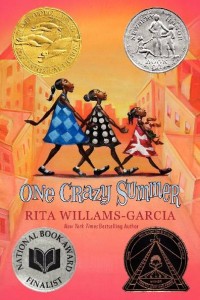 One Crazy Summer by Rita Williams-Garcia
One Crazy Summer by Rita Williams-Garcia
When I first read about Delphine, Vonetta, and Fern riding on an airplane among those “Cassius Clay” clouds, I was hooked. It’s the summer of 1968, and the three sisters are in need of some mother love. From Brooklyn, they fly off to Oakland, California to spend the summer with their estranged mother, Cecile. It’s not exactly an ideal family vacation. Cecile wants nothing to do with the girls, but here they are, plopped on Cecile’s doorstep, dreaming of Disneyland. And wondering, who is this woman that abandoned them? Cecile, in her Cecile way, ignores them, and sends them to a summer camp sponsored by the revolutionary group, the Black Panthers. Delphine is the oldest, the responsible one, and you really feel for her. She steps in and takes care of her sisters, when her mother refuses. With a growing awareness of the Black Panthers’ mission, Delphine and her sisters discover their own place in the movement and the importance of stepping up and taking a stand; while at the same time, they find a way to honor their mother with poetic justice.
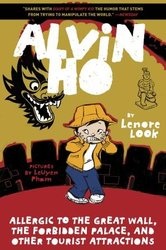 Alvin Ho: Allergic to the Great Wall, the Forbidden Palace, and other Tourist Attractions by Lenore Look. Forthcoming on August 14th 2014.
Alvin Ho: Allergic to the Great Wall, the Forbidden Palace, and other Tourist Attractions by Lenore Look. Forthcoming on August 14th 2014.
Even though this new Alvin Ho book doesn’t take place during the summer, it’s still worth tagging along on this family trip. You’ve got to love Alvin Ho. He’s such a worrywart, you can’t help but wrap your arms around him. With hand sanitizer, of course. The Ho Family takes off for Beijing to visit relatives and Alvin is simply terrified. Luckily, he has his PDK, personal disaster kit. That is, when he doesn’t leave it left behind in bathrooms. Despite a few run-ins with airport security, Alvin arrives in Beijing, jet-lagged, and ready to tackle China. Not. He has to meet new relatives, two of them girls. The Great Wall is too long. The Forbidden City has squat toilets. And he loses his dad’s passport. Despite the horrors, even Alvin manages to make a friend in this land of 1.3 billion people.
Take along Pacy, Delphine, and Alvin on your next adventure. They’re always carry-on friendly.
 Frances Lee Hall’s debut middle grade novel, FRIED WONTON, is forthcoming from Egmont USA in 2015. Frances earned her MFA in Writing for Children and Young Adults from Vermont College of Fine Arts. Find her at www.francesleehall.com and on Twitter @fleehall
Frances Lee Hall’s debut middle grade novel, FRIED WONTON, is forthcoming from Egmont USA in 2015. Frances earned her MFA in Writing for Children and Young Adults from Vermont College of Fine Arts. Find her at www.francesleehall.com and on Twitter @fleehall








